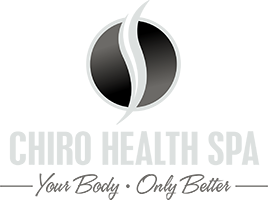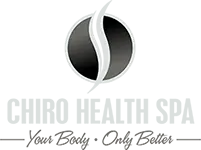When it comes to mid-back pain, it’s important to find the root cause, not just the daily aggravators. Our protocol consists of:
Comprehensive Consultation and Exam
We’re going to sit down with you to dig into your history, as many clues about your mid-back pain come from that discussion. It’s a two-way conversation, as we’re listening intently but providing feedback along the way. During the exam portion, we’ll check things like your mid-back’s range of motion, neck and lower body muscle strength, and perform several orthopedic and neurological tests to see where you are compared to normal. This helps us identify exactly how your mid-back pain is affecting your overall health.
Computerized Posture Analysis
Your neutral standing posture is one of our most important tools to analyze where your mid-back pain is coming from. We take pictures of you from front and side, and by placing digital reference points on your pictures we can see in seconds where your body is under the most stress from poor posture. Most people are amazed as to what they really look like!
Digital X-Rays
We use the most up-to-date technology both when taking and analyzing X-rays to know exactly what we are dealing with before we start care. There are three main things we are looking for in your mid-back X-rays: degeneration, disc spacing, and how far your alignment is from normal alignment.
In the mid-back specifically, we look to see how exaggerated the curvature looks at you from the side (kyphosis), or the back (scoliosis). We know the normal angles and positions of the bones, and we match your X-rays up to those normals to evaluate the strength of your spine.
Once we have evaluated all of the information, we then choose from several therapies, depending upon your condition:
Specific Chiropractic Adjustments
At its core, the spine wants to be neutral. When bones are out of their normal position (sometimes one in a section of your spine, sometimes several), the result is a gradually weakening posture and pressure on the nerves between the bones. By reducing the misalignments in those areas, the spine gets more freedom of motion, allowing its function to improve. We find that improving this alignment with chiropractic adjustments can be significant in reducing the frequency and intensity of mid-back pain.
Custom Therapeutic Exercise Plan
Trying to recover from mid-back pain can’t fully occur if there is muscle weakness or imbalance. If your muscles have been fighting a bad posture for many years (maybe even exaggerated by long hours at a computer, driving, or sitting), getting them strong is a priority.
There are several muscle groups in the mid-back, each with a specific function for flexibility, strength, and posture. You can’t get stronger if you’re a concrete block; therefore, we start by increasing flexibility. Once your range has improved, we then can focus on building your strength. It takes consistency, so we give you a customized exercise plan for both in-office and at home to make sure you’re able to keep aggravating episodes to a minimum, both in frequency and intensity.
Home Care
Keep this in mind: GRAVITY ALWAYS WINS. Your job is to let it win as little as possible for as long as possible. The more you can teach the brain and body to not slouch, stay strong and not fall into a bad position, the more you’ll beat gravity pulling your mid-back down and creating that over-arch that your grandmother had. We’ll give you specific recommendations based on your spine’s shape to ensure strength for years to come.
Electrical Muscle Stimulation
In the initial stages of care, we are looking to reduce muscle spasms and tension in the mid-back. Electrical muscle stimulation is used to accelerate that process, allowing you to feel better and alleviate the stiffness often associated with mid-back pain. Most people say e-stim feels like a light massage and often comment how much looser they feel when it’s done.
Posture Rehabilitation
If your mid-back pain improves but your posture is still poor, the likelihood of having relapses is high. Putting in a plan to create and stabilize good, strong posture is your key to having the longest-lasting results. We’ll utilize various forms of therapy to put your posture in the “mirror image” – essentially, the exact opposite posture that you currently have. (Let’s face it – that posture isn’t helping you, or you wouldn’t have mid-back pain!)
By performing mirror image exercises and traction, your body will gradually learn what “correct” posture is. Each time in-office and at home that your body goes into the mirror image, it’s another signal to the brain, your bones, and your muscles to dump the old, bad patterns and create new, stronger patterns. This may be the most overlooked aspect of mid-back pain – there’s no way a weak posture can help you get better.
Acupuncture
Acupuncture can help remove negative energy and restore positive energy throughout your body. By focusing on specific points and zones in your body, endorphins (the “feel-good” hormones) get released, and that triggers a positive response throughout the body.
Acupuncture has been used for both acute and chronic mid-back pain and can be very beneficial, either on its own or in conjunction with chiropractic and postural rehabilitation.
Supplements and Other At-Home Remedies
Depending on the cause of your mid-back pain, certain nutritional supplements may be worthwhile. However, each case is different, which means your nutritional recommendations may be quite different than someone else you know with mid-back pain. We’ll often recommend certain topical gels or ointments to relieve muscle tension and reduce pain. Some of our recommendations can even be purchased in your local grocery store or health food store.
Lifestyle Changes
Given that we’re working for 8-10 hours a day and sleeping 6-9 hours, whatever posture you’re in had better be right for that amount of time! It’s important that you know how to sleep, how to bend and lift, and how to sit at your computer. It’s just as important to know what not to do. Sometimes simple shifts make the biggest differences, and that’s especially true when it comes to your daily habits. We’ll make sure you know what those shifts are to avoid injury and get the best results in our office.


